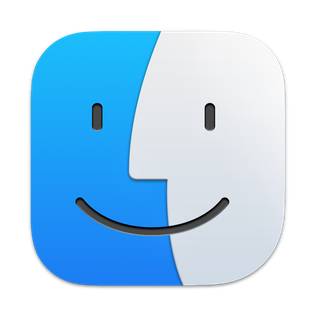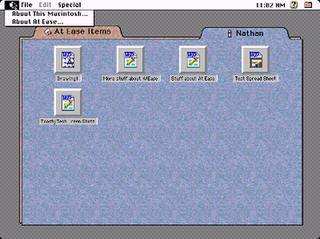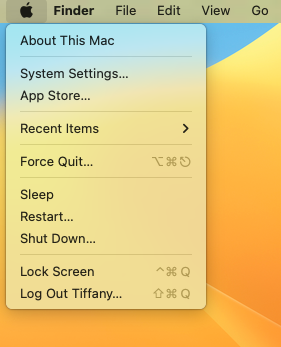Related Research Articles
TrueType is an outline font standard developed by Apple in the late 1980s as a competitor to Adobe's Type 1 fonts used in PostScript. It has become the most common format for fonts on the classic Mac OS, macOS, and Microsoft Windows operating systems.

The Finder is the default file manager and graphical user interface shell used on all Macintosh operating systems. Described in its "About" window as "The Macintosh Desktop Experience", it is responsible for the launching of other applications, and for the overall user management of files, disks, and network volumes. It was introduced with the Macintosh 128K—the first Macintosh computer—and also exists as part of GS/OS on the Apple IIGS. It was rewritten completely with the release of Mac OS X in 2001.

System 7 is the seventh major release of the classic Mac OS operating system for Macintosh computers, made by Apple Computer. It was launched on May 13, 1991, to succeed System 6 with virtual memory, personal file sharing, QuickTime, TrueType fonts, the Force Quit dialog, and an improved user interface.
A desk accessory (DA) or desklet in computing is a small transient or auxiliary application that can be run concurrently in a desktop environment with any other application on the system. Early examples, such as Sidekick and Macintosh desk accessories, used special programming models to provide a small degree of multitasking on systems that initially did not have any other multitasking ability.
In Apple's Macintosh operating systems, labels are a type of seven distinct colored and named parameters of metadata that can be attributed to items in the filesystem. Labels were introduced in Macintosh System 7, released in 1991, and they were an improvement of the ability to colorize items in earlier versions of the Finder. Labels remained a feature of the Macintosh operating system through the end of Mac OS 9 in late 2001, but they were omitted from Mac OS X versions 10.0 to 10.2, before being reintroduced in version 10.3 in 2003, though not without criticism. During the short time period when Mac OS X lacked labels, third-party software replicated the feature.

System 6 is the sixth major release of the classic Mac OS operating system for Macintosh computers, made by Apple Computer. It was released in 1988. It is a monolithic operating system, with cooperative multitasking based on an improved MultiFinder. The boxed version cost US$49, and it was included with all new Macintosh computers until 1991, when it was succeeded by System 7.

Mac OS 8 is the eighth major release of the classic Mac OS operating system for Macintosh computers, released by Apple Computer on July 26, 1997. It includes the largest overhaul of the classic Mac OS experience since the release of System 7, approximately six years before. It places a greater emphasis on color than prior versions. Released over a series of updates, Mac OS 8 represents an incremental integration of many of the technologies which had been developed from 1988 to 1996 for Apple's overly ambitious OS named Copland. Mac OS 8 helped modernize the Mac OS while Apple developed its next-generation operating system, Mac OS X.
Macintosh File System (MFS) is a volume format created by Apple Computer for storing files on 400K floppy disks. MFS was introduced with the original Apple Macintosh computer in January 1984.

Apple Inc. uses a large variety of typefaces in its marketing, operating systems, and industrial design with each product cycle. These change throughout the years with Apple's change of style in their products. This is evident in the design and marketing of the company. The current logo is a white apple with a bite out of it, which was first utilized in 2013.

At Ease was an alternative to the Macintosh desktop developed by Apple Computer in the early 1990s for the classic Mac OS. It provided a simple environment for new Macintosh users and young children to help them to work without supervision. At Ease replaces the Finder desktop, providing a simple tabbed panel-oriented graphical user interface in which applications and documents are represented by icons on large buttons. Aside from its security features, its interface and basic functionality is very similar to the Packard Bell Navigator.
On the classic Mac OS, extensions were small pieces of code that extended the system's functionality. They were run initially at start-up time, and operated by a variety of mechanisms, including trap patching and other code modifying techniques. Initially an Apple developer hack, extensions became the standard way to provide a modular operating system. Large amounts of important system services such as the TCP/IP network stacks and USB and FireWire support were optional components implemented as extensions. The phrase "system extension" later came to encompass faceless background applications as well.
Font Book is a font manager by Apple Inc. for its macOS operating system. It was first released with Mac OS X Panther in 2003.
Extension conflicts were sometimes a common nuisance on Apple Macintosh computers running the classic Mac OS, especially System 7. Extensions were bundles of code that extended the operating system's capabilities by directly patching OS calls, thus receiving control instead of the operating system when applications made system calls. Generally, once an extension completed its task, it was supposed to pass on the system call to the operating system's routine. If multiple extensions want to patch the same system call, they end up receiving the call in a chain, the first extension in line passing it on to the next, and so on in the order they are loaded, until the last extension passes to the operating system. If an extension does not hand the next extension in line what it is expecting, problems occur; ranging from unexpected behavior to full system crashes. This is triggered by several factors such as carelessly programmed and malicious extensions that change or disrupt the way part of the system software works.
The System folder is the directory in the classic Mac OS that holds various files required for the system to operate, such as fonts, system extensions, control panels, and preferences.
In the macOS operating system, .DS_Store is a file that stores custom attributes of its containing folder, such as folder view options, icon positions, and other visual information. The name is an abbreviation of Desktop Services Store, reflecting its purpose. It is created and maintained by the Finder application in every folder, and has functions similar to the file desktop.ini in Microsoft Windows. Starting with a period . character, it is hidden in Finder and many Unix utilities. Its internal structure is proprietary, but has been reverse-engineered. Starting at macOS 10.12 16A238m, Finder will not display .DS_Store files.
Apple's Macintosh computer supports a wide variety of fonts. This support was one of the features that initially distinguished it from other systems.

The Apple menu is a drop-down menu that is on the left side of the menu bar in the classic Mac OS, macOS and A/UX operating systems. The Apple menu's role has changed throughout the history of Apple Inc.'s operating systems, but the menu has always featured a version of the Apple logo.

The Macintosh "System 1" is the first major release of the classic Mac OS operating system. It was developed for the Motorola 68000 microprocessor. System 1 was released on January 24, 1984, along with the Macintosh 128K, the first in the Macintosh family of personal computers. It received one update, "System 1.1" on December 29, 1984, before being succeeded by System 2.

Mac OS is the series of operating systems developed for the Macintosh family of personal computers by Apple Computer, Inc. from 1984 to 2001, starting with System 1 and ending with Mac OS 9. The Macintosh operating system is credited with having popularized the graphical user interface concept. It was included with every Macintosh that was sold during the era in which it was developed, and many updates to the system software were done in conjunction with the introduction of new Macintosh systems.
Comparison of user features of operating systems refers to a comparison of the general user features of major operating systems in a narrative format. It does not encompass a full exhaustive comparison or description of all technical details of all operating systems. It is a comparison of basic roles and the most prominent features. It also includes the most important features of the operating system's origins, historical development, and role.
References
- Broback, Steve; Williams, Robin (1997). Beyond The Little Mac Book. Berkeley, California: Peachpit. ISBN 0-201-88666-9.
- Danuloff, Craig; Bell, Mark R. (1997). The Mac OS 8 Book (4th ed.). Ventana (International Thomson Publishing). ISBN 1-56604-688-2.
- Giordan, Daniel; Boylan, Kelly; Donohoe, Brendan; Szabo, Michelle (1996). Wilson, Lisa (ed.). The Whole Mac: Solutions for the Creative Professional. Hayden Books. ISBN 1-56830-298-3.
- LeVitus, Bob; Miller-Love, Laurie (1992). Dr. Macintosh (2nd ed.). Addison-Wesley. ISBN 0-201-57050-5.
- Pogue, David (April 1998). The Great Macintosh Easter Egg Hunt. New York, Yew York: Berkley Books. ISBN 0-425-16006-8.
- Rietmann, Kearney; Higgins, Frank (1994). Upgrading & Fixing Macs for Dummies. IDG Books. ISBN 1-56884-189-2.
- Rubin, Charles (1991). The Macintosh Bible Guide to System 7. Berkeley, California: Goldstein & Blair. ISBN 0-940235-21-8.